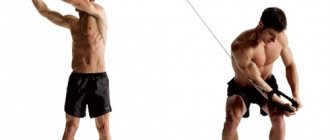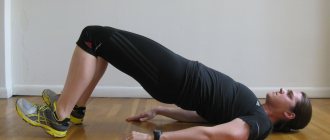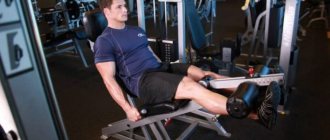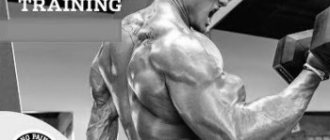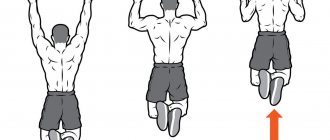Author: Timko Ilya - the ruler of the entire site and fitness trainer | more details >> Rod. 1984 Trained since 1999 Trained since 2007. Author and creator of the site tvoytrener.com. CCM in powerlifting. Champion of Russia and South Russia according to AWPC. Champion of the Krasnodar region according to IPF. 1st category in weightlifting. 2-time winner of the Krasnodar Territory championship in t/a. Author of more than 700 articles on fitness and amateur athletics. Author and co-author of 5 books.
Place in the ranking of authors:
out of competition
(become an author)
Date:
2013-11-216
Views:
22,977
Rating:
5.0
| All articles by the author >> | Medals articles >> |
Articles are loading...
Hello. Probably many of you have heard about this method in bodybuilding. Now I will try to briefly define it.
The pre-fatigue method is when the target muscle group is specifically fatigued (hammered) with isolated exercises before performing the main exercise.
As most of you know, the classic scheme is when you do basic exercises, and after them, isolated ones.
Isolated exercises are exercises in which only the target muscle group or one muscle is worked.
Let's say the squat with a barbell is a basic exercise for the thigh muscles. And straightening your legs while sitting in a machine is already an isolated exercise.
That is, in the classical scheme, first we train the whole body, and then we work on specific muscles, “finishing off” them with isolated exercises. This option is quite logical from a physiological point of view.
But with the pre-fatigue method, everything is done the other way around. Let's say we first straighten our legs in the simulator, and only then go to squat. That is, we specifically tired the hip extensor muscles before squats. Where these same muscles also work. But in conjunction with other muscles.
Content
- 1 Pre-fatigue methods
- 2 Research
- 3 Practical approach 3.1 Complex for deltoid muscles
Video: pre-exhaustion
The purpose of pre-exhaustion is to load the target muscle with an isolation exercise, and then quickly move on to the basic exercise. If you look at it from a theoretical point of view, the idea is not bad, but it almost always doesn’t work out.
The maximum effect is achieved if the target muscle is very strong and cannot be penetrated by basic training alone. But the result will be much worse in the case when neither the insulating nor the base can reach the target area and it is not possible to direct the load to the right place.
A variation on the theme of pre-fatigue is “double split” training, which involves loading the target muscle at a time and in a situation when it is already tired. According to Ch. Poliquin, the best effect from muscle loading will be if you work with the target twice a day, or two days in a row.
In such a situation, the principle of constructing training with the inclusion of preliminary fatigue actually makes it possible to force a larger number of muscle fibers to work.
https://youtu.be/4-9U54x5ylY
Pre-fatigue methods
Since training load is responsible for stimulating the growth of muscle cells, it helps the formation of certain biological factors. Namely, in the body there is an accumulation of free creatine, hydrogen ions, in muscle fibers that undergo training, and, of course, there is a high level of anabolic hormone in the blood and cells.
Tension in itself does not mean anything to the muscles, otherwise the loaders would be excellent bodybuilders. The result can only be achieved under optimal conditions; a certain intensity and duration are required. The duration of the load should correspond to what is required before the onset of muscle failure. There is no need to do less, much less more. Finding the golden mean is the task. But knowing the physiology of muscle tissue and the factors that can stimulate hypertrophy, you can more objectively assess a particular training load.
Pre-fatigue sets the task of performing an isolating exercise, which precedes the basic one, and the muscle group is the same. There are two ways to use pre-fatigue.
The first involves performing several sets of the same exercise, most often it is isolating. After this comes a series of complex sets. The second scheme implies high intensity, namely: the first exercise (one set), followed immediately without a break by the second (one set). The second concept allows you to significantly reduce training time; it fits organically into the concept of “limiting the amount of exercise”, which leads to stimulation of muscle growth.
The principle of training, which is based on preliminary fatigue, is advisable to use in the initial stages of training. Sometimes it can be useful for experienced athletes. For example, in a situation of injury, if it is not possible to work with the usual weights, then the blood that is pumped into the muscles will help heal the injury.
In order to choose the right pair of exercises in pre-exhaustion training, it is important to understand the basic scheme of its action. First, the isolating movement is turned on, then it is achieved with the basic one. The first most often involves the work of one joint or muscle group, while excluding the work of the rest. The basic one also has a target focus on the muscle being worked, but in addition to this, auxiliary ones are involved in the work. The success of performing the basic exercise is guaranteed by the not yet tired “assistants”, but at the same time the target muscle also works. This allows you to give her a killer load.
What are pre-exhaustion and post-exhaustion in training?
And so, you are already familiar with what a superset and triset are - now it’s time to get acquainted with such complex, at first glance, concepts as pre-fatigue and post-fatigue. These techniques are often used in training, especially in combination with a superset. So what is it?
These techniques are an arsenal of tools for an experienced athlete who has been practicing for more than a year. Their essence is to tire the muscle as much as possible by giving it an unusual load.
Pre-fatigue
The pre-exhaustion (or exhaustion) technique is as follows: first you perform isolation exercises, and then basic exercises, while you work the same muscle group. The point of the technique is that by the time you perform basic exercises (which are more complex movements with more weight), your muscles are already in the pre-fatigue stage. It is assumed that when performing basic exercises, the muscles will work more diligently.
What is the point of pre-exhaustion in terms of benefits for muscle growth? It's simple: in a basic exercise, we often don't get enough load on the large muscle group, because the small muscle groups, such as the wrists, triceps and others, are the first to "turn off". For example, it is quite difficult for many to “feel” the chest muscles in the bench press, because the load is placed on the shoulders and arms and even on the back. =
Here are some examples of this technique for different muscle groups:
- Quadriceps - leg extension in a machine (isolating exercise), followed by squats (basic exercise);
- Hind thighs - leg curls in a lying machine (isolating exercise), followed by the Romanian deadlift (basic exercise);
- Pectoral muscles - Dumbbell flyes (isolating exercise), followed by bench press (basic exercise);
- Shoulders - raising dumbbells to the sides (isolating exercise), after which lifting the barbell while standing (basic exercise);
- Back - pulling down the upper block while standing (isolating exercise), followed by pull-ups (basic exercise);
- Triceps - French press (isolating exercise), followed by a bench press with a narrow grip (basic exercise);
Pre-exhaustion is suitable for those people who experience that their large muscle groups are not growing well. This can often be seen in the pectoral muscles. If you bench press frequently and with adequate weight and don’t see any growth in your pecs, try the pre-exhaustion technique.
Post-fatigue
Post-exhaustion is a variation of a superset. The bottom line is that you perform 2 exercises for one muscle group one after another, the first of which is a basic exercise, and the second is an isolating exercise. Limited rest between sets. The goal of this method is to push the muscles to near failure with heavy weights on a basic exercise and then push them to complete fatigue with an isolation exercise.
Here are some examples of this technique:
- Chest - bench press followed by dumbbell flyes;
- Back - bent over row of the barbell, followed by a standing downward row of the upper block;
- Shoulders - standing barbell shvung, followed by dumbbell raises to the sides;
- Quadriceps - squats followed by leg extensions in the machine;
- Posterior thighs - Romanian deadlift followed by leg curls in a lying machine;
- Triceps - bench press with a narrow grip followed by triceps push-ups;
If you have any questions about using these techniques, leave them in the comments.
Research
At this time, among many published studies of this phenomenon, I would like to note the second. The first was carried out using the electromyography method; it demonstrated muscle activity during the execution of a particular exercise. The subjects squatted, but one group had a preload (extension of the quadriceps and lower legs), the other did not have such a load. As a result, the second group showed higher muscle activity when squatting. From this we can conclude that muscle hypertrophy depends on the tension and time during which they were loaded. This study showed that the use of pre-fatigue is inappropriate and this training strategy is incorrect.
The second exercise experiment involved the leg press. 17 men took part in it, some of them performed only the bench press, and the second part was a superset that combined the press and calf extension. Both did 10 repetitions until failure. The results of muscle activity were measured by an electromyograph. And they showed that the anterior thigh muscle was smaller during the preexhaustion superset, compared to the data that the athletes reported performing a single compound exercise. This means that by first tiring the quadriceps and then doing the basic exercise, athletes were able to use other muscles, and they take on the main load. As a result, the value of the barbell squat as a compound exercise is reduced when considering its benefits for the quadriceps. But when using anabolic steroids this is not so important. After all, the conditions for stimulating hypertrophy can be met, namely: free creatine accumulates, and its amount is quite large, since the active load continues for a long time. The concentration of lactic acid also increases, the use of anabolic hormones will allow them to have a high level anyway.
But those athletes who do not take anabolic steroids should be careful, because such a method will not lead to anything good.
Practical approach
If we look at specific practical examples, the standard scheme is called “pre-fatigue”. It involves performing an isolating exercise, followed by a basic one. The point of this technique is to preload the target muscle followed by a heavy load. As a result, the primary load will become the strongest for the muscle and will be able to break through each of its fibers.
Important! You should play it safe and do this training with an assistant. Since when approaching the basic exercise the main muscles are already tired, injury is likely.
But there is another option - changing the execution order. To begin with, with new strength, you begin basic training, stopping it one repetition before failure, then bring it to failure, but using a targeted load. As a result, you can get the same pre-fatigue (but at the expense of the base one). In this case, the risk of injury is significantly reduced.
Some tips for pre-exhaustion training
- As you perform the base, tense the target muscles to reduce the load on other groups.
- To increase the intensity of your workout, do pre-exhaustion supersets. After isolation exercises, immediately begin basic exercises.
- Since it is difficult to target only the back muscles when performing deadlifts, do them after all other back exercises.
- You can do all the isolation exercises, such as three types of biceps curls, and finish with basic exercises, for example, pull-ups on the horizontal bar.
The procedure for performing pre-exhaustion for the triceps:
- triceps press down on a block - 3 sets of 12-15 repetitions;
- push-ups in the simulator - 3 sets of 10-12 repetitions;
- triceps extension on a block - 3 sets of 12-15 repetitions;
- Bench press with a narrow grip - 3 sets of 10-12 repetitions.
https://youtu.be/O4pPw5V_e5g
“The weakest link breaks first” - this rule is confirmed when using pre-fatigue. You can be sure that a separate muscle group worked out according to this training principle will become the weakest when performing multi-joint exercises: the target muscle will be worked to the maximum and fail, while others will still be capable of much. When used correctly, the pre-exhaustion technique proves that the weakest link, despite quite heavy strength work on it, can be the most effective stimulator of muscle hypertrophy.
